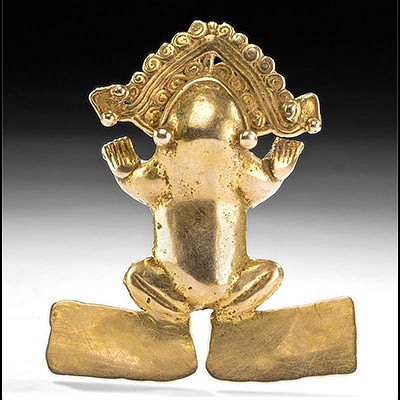Greek Core-Form Glass Amphoriskos Fine Iridescence
Lot 12d
About Seller
Artemis Fine Arts
686 S Taylor Ave, Ste 106
Louisville, CO 80027
United States
Selling antiquities, ancient and ethnographic art online since 1993, Artemis Gallery specializes in Classical Antiquities (Egyptian, Greek, Roman, Near Eastern), Asian, Pre-Columbian, African / Tribal / Oceanographic art. Our extensive inventory includes pottery, stone, metal, wood, glass and textil...Read more
Categories
Estimate:
$3,000 - $4,500
Absentee vs Live bid
Two ways to bid:
- Leave a max absentee bid and the platform will bid on your behalf up to your maximum bid during the live auction.
- Bid live during the auction and your bids will be submitted real-time to the auctioneer.
Bid Increments
| Price | Bid Increment |
|---|---|
| $0 | $25 |
| $300 | $50 |
| $1,000 | $100 |
| $2,000 | $250 |
| $5,000 | $500 |
| $10,000 | $1,000 |
| $20,000 | $2,500 |
| $50,000 | $5,000 |
| $100,000 | $10,000 |
| $200,000 | $20,000 |
About Auction
By Artemis Fine Arts
Aug 13, 2020
Set Reminder
2020-08-13 10:00:00
2020-08-13 10:00:00
America/New_York
Bidsquare
Bidsquare : Fine Antiquities, Ethnographic & Fine Art
https://www.bidsquare.com/auctions/artemis-gallery/fine-antiquities-ethnographic-fine-art-5415
Features classical antiquities, ancient and ethnographic art from cultures encompassing the globe. Egyptian, Greek, Roman, Etruscan, Near Eastern, Asian, Pre-Columbian, Native American, African / Tribal, Oceanic, Spanish Colonial, Russian, Fine Art, so much more! Artemis Fine Arts info@artemisgallery.com
Features classical antiquities, ancient and ethnographic art from cultures encompassing the globe. Egyptian, Greek, Roman, Etruscan, Near Eastern, Asian, Pre-Columbian, Native American, African / Tribal, Oceanic, Spanish Colonial, Russian, Fine Art, so much more! Artemis Fine Arts info@artemisgallery.com
- Lot Description
Ancient Greece, Classical Period, ca. 6th to 5th century BCE. A stunning example of a core-formed glass amphoriskos once used to contain perfumes and scented oils. The vessel is formed with opaque glass of a cobalt blue hue and exhibits several impressed vertical grooves that form shallow ribs around the circumference of the upper body. The lower body tapers to form a discoid foot, rounds on top to form the shoulder, has a cylindrical neck surmounted by a gently flared rim, and bears a pair of arching trail handles joining neck to shoulder. The body is decorated with trails of blue and yellow glass feathered into a zigzagging register that is enclosed with shallow concentric rings, and both rim and foot are encircled with a thin ring of yellow glass. While silvery and rainbow-hued iridescence have formed across the surface, scattered areas of golden iridescence imbue this amphoriskos with exceptional opulence and beauty. Size: 2.1" W x 3.6" H (5.3 cm x 9.1 cm); 4.5" H (11.4 cm) on included custom stand.
A vessel like this would have been made for the elites of ancient society. Its owner would have used a stopper to keep the contents inside, and a glass rod to dip into the vessel's perfumed oils and dab on the throat or wrists. The little handles made it possible to suspend the vessel, and we know from Athenian vase paintings that vessels like these could be worn off a belt at the waist or suspended from the wrist.
The Greeks created core-formed or sandcore vessels by trailing threads of molten glass over a "core" of sand or clay to form the vessel. These threads were oftentimes feathered or dragged to create intriguing decorative patterns. The term amphoriskos literally means "little amphora" and is indeed a miniature amphora. This shape was quite popular as it was ideal to store precious oils, perfumes, or cosmetics.
For a strikingly similar example without much iridescence, please see "Reflections of the Past: A Selection of Objects from the Ancient World." Fortuna Fine Arts, Ltd., New York, 2001, fig. 23.
For another strikingly similar example with shorter handles and a squat neck, please see The Metropolitan Museum of Art, accession number 17.194.779.
A third strikingly similar example, of a shorter size, hammered for $6,250 at Christie's, New York "Antiquities" auction (sale 2856, June 5, 2014, lot 40).
Provenance: ex-Jack P. Minor collection, New York, USA, acquired in the 1950s
All items legal to buy/sell under U.S. Statute covering cultural patrimony Code 2600, CHAPTER 14, and are guaranteed to be as described or your money back.
A Certificate of Authenticity will accompany all winning bids.
We ship worldwide and handle all shipping in-house for your convenience.
#153158Repairs to handles, neck, rim, and foot, with very small chips and light adhesive residue along break lines. Minor nicks to rim, handles, body, and foot, with light encrustations, and extensive but shallow pitting. Light earthen deposits as well as stunning silver, rainbow, and golden iridescence throughout.Condition
- Shipping Info
-
All shipping is handled in-house for your convenience. Your invoice from Artemis Gallery will include shipping calculation instructions. If in doubt, please inquire BEFORE bidding for estimated shipping costs for individual items.
-
- Buyer's Premium



 EUR
EUR CAD
CAD AUD
AUD GBP
GBP MXN
MXN HKD
HKD CNY
CNY MYR
MYR SEK
SEK SGD
SGD CHF
CHF THB
THB














